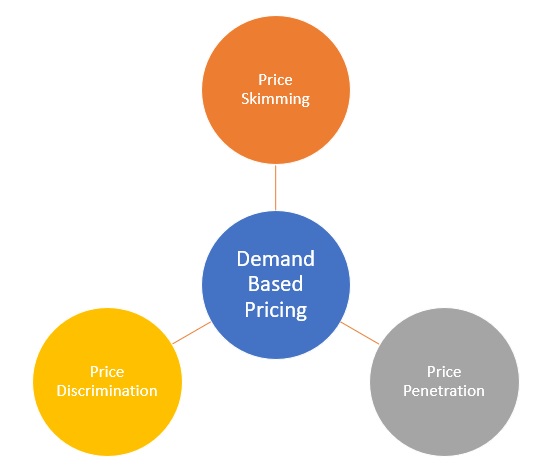Demand Based Pricing - Definition, Importance & Example
What is Demand Based Pricing?
Demand Based Pricing is a pricing method based on the customer’s demand and the perceived value of the product. In this method the customer’s responsiveness to purchase the product at different prices is compared and then an acceptable price is set.
Demand is rarely consistent across products and markets. Consumer behavior and demand keeps changing based on various parameters so the pricing methods based on demand are are used.
Demand based Pricing methods
There are 3 main demand-based pricing methods:
1. Price Skimming
Initial price is set very high so that only the customers with more purchasing power can buy the product. After that the price is reduced gradually so that the price-sensitive customers who were not able to buy the product at first can now buy. Finally the price at which the company can operate in profit is set up.
This way a company gets ahead of any competition and by the time other companies can come to the market this company already makes the profit. Electronic products are priced this way.
2. Price Discrimination
Customers are charged differently based on different demand. For example the airline ticket prices increase as the travel date gets closer. Inelastic demand during the end makes the price very high.
Another type of price discrimination is when customers in different markets/areas are charged differently for the same product or service.
3. Price Penetration
This is exact opposite to the price skimming. In this method the initial price is kept really low to attract more customers and increase the market share.
Discounts, inaugural price, first 100 buyers etc. are some of the methods.

Importance of Demand Based Pricing
Demand Based Pricing is very important for the industries in price sensitive markets. Demand Based pricing is a strategy which will help increase revenues in the demand months to drive growth of the company. If the rise in demand of the product is not marked with increase in revenue, this would become opportunity loss for the company.
There are many industries where demand fluctuates a lot e.g. clothing and apparel. Based on season one kind of clothing will be more in demand as compared to others. Jackets will more be in demand in winters.
Here demand based pricing will become very important.
Example of Demand Based Pricing
Sectors like Transportation, Aviation use demand based pricing effectively. We see that the train tickets during holiday season would be costlier than off season.
Similarly products like Air Conditional and air coolers become costly during the summer seasons as compared to winters where the demand for radiators and heaters would go high driving their costs higher.
Hence, this concludes the definition of Demand Based Pricing along with its overview.
This article has been researched & authored by the Business Concepts Team. It has been reviewed & published by the MBA Skool Team. The content on MBA Skool has been created for educational & academic purpose only.
Browse the definition and meaning of more similar terms. The Management Dictionary covers over 1800 business concepts from 5 categories.
Continue Reading:
What is MBA Skool?About Us
MBA Skool is a Knowledge Resource for Management Students, Aspirants & Professionals.
Business Courses
Quizzes & Skills
Quizzes test your expertise in business and Skill tests evaluate your management traits
Related Content
All Business Sections
Write for Us